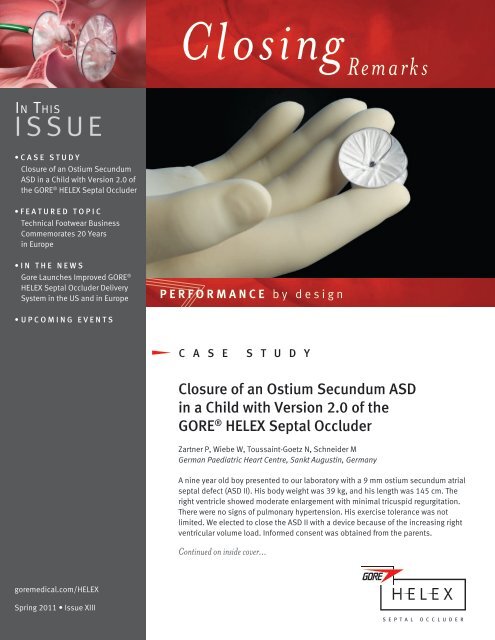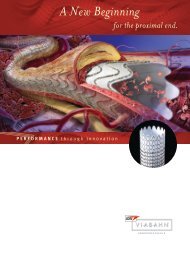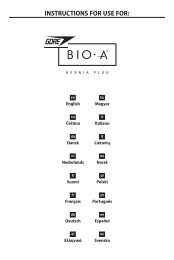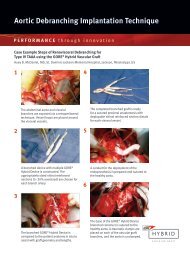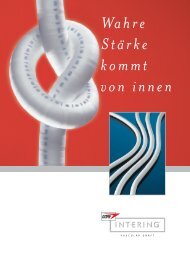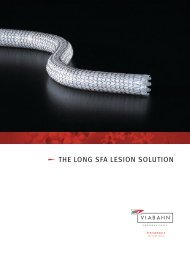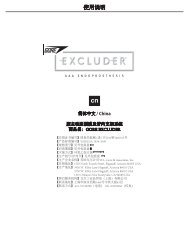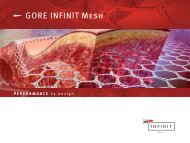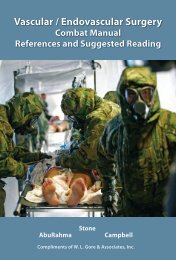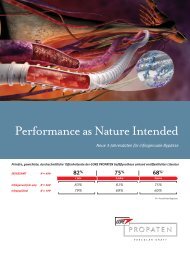Printable PDF Version - Gore Medical
Printable PDF Version - Gore Medical
Printable PDF Version - Gore Medical
Create successful ePaper yourself
Turn your PDF publications into a flip-book with our unique Google optimized e-Paper software.
Closing Rem a rk s<br />
In This<br />
I S S U E<br />
• C A S E S T U D Y<br />
Closure of an Ostium Secundum<br />
ASD in a Child with <strong>Version</strong> 2.0 of<br />
the GORE ® HELEX Septal Occluder<br />
• F E A T U R E D T O P I C<br />
Technical Footwear Business<br />
Commemorates 20 Years<br />
in Europe<br />
• I N T H E N E W S<br />
<strong>Gore</strong> Launches Improved GORE ®<br />
HELEX Septal Occluder Delivery<br />
System in the US and in Europe<br />
P E R F O R M A N C E b y d e s i g n<br />
• U P C O M I N G E V E N T S<br />
C A S E S T U D Y<br />
Closure of an Ostium Secundum ASD<br />
in a Child with <strong>Version</strong> 2.0 of the<br />
GORE ® HELEX Septal Occluder<br />
Zartner P, Wiebe W, Toussaint-Goetz N, Schneider M<br />
German Paediatric Heart Centre, Sankt Augustin, Germany<br />
A nine year old boy presented to our laboratory with a 9 mm ostium secundum atrial<br />
septal defect (ASD II). His body weight was 39 kg, and his length was 145 cm. The<br />
right ventricle showed moderate enlargement with minimal tricuspid regurgitation.<br />
There were no signs of pulmonary hypertension. His exercise tolerance was not<br />
limited. We elected to close the ASD II with a device because of the increasing right<br />
ventricular volume load. Informed consent was obtained from the parents.<br />
Continued on inside cover...<br />
goremedical.com/HELEX<br />
Spring 2011 • Issue XIII
Closure of an Ostium Secundum ASD in a Child with<br />
<strong>Version</strong> 2.0 of the GORE ® HELEX Septal Occluder Continued from cover...<br />
The procedure was undertaken under<br />
general anesthesia. Transesophageal<br />
echocardiography demonstrated a<br />
6 mm rim near the aortic root and a<br />
total septal length of 42 mm in the<br />
4-chamber view. We confirmed that<br />
the pulmonary veins drained to the<br />
left atrium. The Eustachian valve was<br />
noted to bulge a little towards the<br />
tricuspid valve, but it did not cause any<br />
turbulence and was distant from the<br />
atrial septum. The distance between the<br />
defect and the AV-valves was 10 mm<br />
and 12 mm to the tricuspid valve and<br />
the mitral annulus, respectively. There<br />
was a notable amount of left to right<br />
shunt across the ASD with a maximum<br />
flow of 1.6 m / s. The pulmonary valve<br />
showed minimal regurgitation and was<br />
mildly enlarged, compared with the<br />
aortic root. Biventricular function was<br />
unrestricted and within the normal<br />
range.<br />
The left femoral vein was punctured<br />
and an 8 Fr short introducer sheath<br />
was inserted. Following an assessment<br />
of pressures and blood saturations, it<br />
was concluded that a significant left to<br />
right shunt was present necessitating<br />
device closure. 1.5 g of cefuroxim and<br />
100 units / kg of heparin were given.<br />
Then, a stiff 0.035” guide wire was<br />
placed across the defect into the left<br />
upper pulmonary vein. Using a 20 mm<br />
sizing balloon, the mildly stretched<br />
diameter of the defect was evaluated<br />
by echocardiography and angiography<br />
simultaneously. Defect measurements<br />
ranged from 10 to 12 mm. To fulfill<br />
the criteria of a 2:1 device diameter to<br />
defect diameter sizing ratio, we elected<br />
to implant a 25 mm GORE ® HELEX<br />
Septal Occluder. The 8 Fr short sheath<br />
Figure 1: Transthoracic echocardiography revealed a 10 mm ASD II with<br />
left to right shunting and enlargement of the right atrium and ventricle.<br />
The overall atrial septal length was estimated as 4.2 cm.<br />
Figure 2: Pre-interventional transesophageal echocardiography<br />
confirmed the transthoracic findings. The ASD II measured as 9 mm<br />
and with sufficient rims.
was exchanged for a 10 Fr introducer in<br />
preparation for delivery of the device.<br />
Figure 3: After measuring the oxygen saturations and calculating the<br />
shunt volume, balloon sizing was performed. The balloon is inflated<br />
until a distinctive waist was seen.<br />
Figure 4: Invasive balloon sizing was accompanied by transesophageal<br />
measurements of the balloon’s waist until a significant reduction of the<br />
shunt has been observed. In this case, the defect measured 10 mm by<br />
fluoroscopy and 9.2 mm by echocardiography.<br />
The 25 mm GORE ® HELEX Septal<br />
Occluder was loaded into its green<br />
delivery catheter. The guide wire was<br />
retrieved and the delivery system<br />
advanced through the defect to the left<br />
atrium. All further steps were performed<br />
under fluoroscopy and were controlled<br />
by transesophageal echocardiography.<br />
The left disc was deployed step by<br />
step using the repeated push-pinchpull<br />
technique and then subsequently<br />
retracted to the atrial septum.<br />
Echocardiography revealed that the left<br />
disc was unequally deployed across the<br />
atrial septum, with approximately half<br />
of the device in the left atrium and the<br />
other half prolapsed across the atrial<br />
septum. Thus, it was decided to retrieve<br />
and reposition the left atrial disc.<br />
These maneuvers were aided by the<br />
improved device’s features including<br />
the stiffened, radiopaque mandrel and<br />
the hydrophilic lubricious coating that<br />
resides on the gray control catheter.<br />
Following successful deployment of<br />
the left disc, the device was again<br />
drawn back to the atrial septum. It<br />
was noted that the left disc apposed<br />
the septum well. The right atrial<br />
disc was subsequently deployed by<br />
first withdrawing the green delivery<br />
catheter and then advancing the<br />
gray control catheter. After having<br />
unscrewed the mandrel luer, all three<br />
eyelets adjusted well in the center of<br />
the device. The position of the device<br />
relative to all cardiac structures was<br />
evaluated by echocardiography. After<br />
final confirmation that the device was<br />
appropriately placed, the mandrel was<br />
sharply pulled to release the device.
This resulted in all three eyelets being<br />
successfully captured by the locking<br />
loop. There was no residual shunt<br />
around the device and its proper<br />
position was documented.<br />
The patient received 400 units / kg of<br />
heparin for 24 hours and 200 units / kg<br />
for another day. Antibiotics were<br />
repeated twice during the first 24 hours.<br />
Transthoracic echocardiography showed<br />
a good result with no residual shunt.<br />
The patient was dismissed 48 hours<br />
after the procedure.<br />
Discussion:<br />
This was our first implantation of<br />
<strong>Version</strong> 2.0 of the GORE ® HELEX Septal<br />
Occluder. Several modifications of<br />
the prior version have been made by<br />
W. L. <strong>Gore</strong> & Associates to improve<br />
the handling of the delivery system.<br />
Specifically, the mandrel has been<br />
reinforced by a stainless steel wire to<br />
prevent potential kinking. This issue<br />
intermittently occurred with the previous<br />
version when the distal end of the<br />
mandrel was sharply bent or pushed<br />
forward during the delivery procedure.<br />
The result of a kinked mandrel included<br />
an inability to properly configure the<br />
left-sided disc, thus alleviation of this<br />
potential issue with the new version of<br />
the device is a beneficial improvement.<br />
Despite the mandrel stiffener, it is still<br />
recommended to not push the mandrel<br />
forward during the procedure, which<br />
is under normal circumstances an<br />
unnecessary maneuver.<br />
As a second modification, the gray<br />
control catheter of the improved device<br />
now has a hydrophilic lubricious coating<br />
intended to decrease the frictional<br />
forces within the delivery catheter.<br />
This markedly improves the kinesthetic<br />
feel with which the device may be<br />
deployed. In our case, the decreased<br />
Figure 5: In the first attempt, the device was noted to be unequally deployed<br />
across the septum. The device was completely reloaded into the delivery<br />
catheter and a second attempt was initiated.<br />
Figure 6: Under echocardiography guidance, the left side of the<br />
GORE ® HELEX Device showed a flat configuration and was noted to be<br />
well-apposed to the atrial septum.<br />
Figure 7: Following deployment of the right disc, echocardiography<br />
revealed that the device was in good position, capturing the septal tissue.<br />
No residual shunt was seen.
friction contributed to a non optimal<br />
configuration of the left disc. However,<br />
this was easily corrected by controlling<br />
both the gray control catheter and the<br />
green delivery catheter together during<br />
the deployment of the left atrial disc.<br />
Figure 8: Fluoroscopy demonstrated normal configuration of the<br />
GORE ® HELEX Septal Occluder.<br />
The third modification to the device<br />
includes the substitution of the existing<br />
retrieval cord with a stronger cord.<br />
This component, as with the previous<br />
version of the device, enables retrieval<br />
of the device after full deployment<br />
and release from the delivery system.<br />
The modified retrieval cord allows for<br />
higher tensile forces to be applied<br />
before a potential cord break occurs.<br />
In our experience this might become<br />
important if the device got entangled<br />
within intra-atrial structures, like the<br />
Eustachian valve. In this case, higher<br />
forces may be needed to overcome the<br />
resistance and pull the device down to<br />
the inferior vena cava for retrieval into<br />
the delivery catheter.<br />
Conclusion:<br />
Figure 9: Following lock release, the locking loop was noted to have<br />
captured all three eyelets.<br />
Figure 10: Echocardiography revealed the final position of the device<br />
following removal of the retrieval cord. The right and left discs were in<br />
good apposition with the atrial septum, and no residual shunt was noted.<br />
The modifications embodied in <strong>Version</strong><br />
2.0 of the GORE ® HELEX Septal Occluder<br />
offer a series of noted benefits without<br />
significantly altering the implantation<br />
procedure associated with deployment<br />
of the device. These modifications<br />
enhance the usability of the device by<br />
reducing the rate for potential delivery<br />
system issues. Overall the new delivery<br />
system supports straight forward<br />
implantation procedures with a good<br />
final result more so than the previous<br />
versions of the GORE ® HELEX Septal<br />
Occluder.<br />
Please refer to GORE ® HELEX Septal<br />
Occluder Instructions for Use at<br />
goremedical.com for a complete<br />
description of all indications,<br />
contraindications, warnings,<br />
precautions and adverse events.
F E A T U R E D T O P I C<br />
Technical Footwear Business Commemorates 20 Years in Europe<br />
Serves Military and Workforce Markets<br />
“Soaking wet, full of blisters and<br />
generally sore”—this is how a German<br />
military major described the condition of<br />
his soldiers’ feet following a high-altitude<br />
mission in the rain and snow more than<br />
two decades ago. In fact, their feet were<br />
so wet and wounded they had to cancel<br />
their mission.<br />
This negative experience led to a<br />
partnership between <strong>Gore</strong> and the German<br />
Armed Forces, and, ultimately, to the first<br />
commercialized GORE-TEX ® footwear<br />
product within Europe’s Technically<br />
Oriented Fabrics business unit.<br />
That product—a waterproof mountaineer<br />
boot for Germany’s Federal Defense Force—<br />
paved the way for additional contracts with<br />
European military units, as well as various<br />
sectors of the European workforce.<br />
“Our level of innovation, our outstanding<br />
technology and the quality and durability<br />
of our products set us apart from<br />
competitors,” says European Footwear<br />
business leader Günter Nötzold.<br />
Meeting Diverse Needs<br />
When the technical footwear business<br />
first began, it leveraged resources from<br />
<strong>Gore</strong>’s consumer footwear business,<br />
which already had a presence in the<br />
United States and Europe. Today, these<br />
businesses continue to benefit from a<br />
number of the same tools, such as the<br />
“whole boot comfort test” designed<br />
to measure breathability. But each<br />
business also has its own set of unique<br />
resources, based on customer and<br />
enduser requirements.<br />
Günter, who started in consumer<br />
footwear, says the growth of technical<br />
footwear over the past two decades<br />
has exceeded expectations. He adds,<br />
“The reaction from end-users is always<br />
very positive. They comment on how<br />
comfortable and reliable our footwear is.”<br />
There are more than 450 styles of<br />
GORE‐TEX ® footwear for the military and<br />
workplace markets in Europe. End-users<br />
include firefighters, law enforcement<br />
Firefighters in Reutlingen, Germany, are among<br />
the many who rely on GORE-TEX ® footwear to<br />
keep their feet comfortable and safe. The brand<br />
is the market leader in the firefighting and police<br />
segments in Germany.<br />
officials, construction workers and railway<br />
workers, among others. “We strive to<br />
maintain optimum skin temperature and<br />
humidity under all conditions and in all<br />
categories,” Günter says.<br />
To meet the diverse needs of different<br />
end-users, three product classes exist: one<br />
for use in cold weather, another for use in<br />
moderate to warm weather and another<br />
for use in changing weather conditions. In<br />
addition to protecting against the weather,<br />
GORE‐TEX ® footwear also protects against<br />
chemicals and bloodborne pathogens in<br />
certain applications.<br />
“We work hard to understand the specific<br />
needs of each end-user,” Günter says.<br />
“Whether you’re exposed to freezing cold<br />
temperatures, the desert heat or chemical<br />
and biological agents, we have a solution<br />
engineered for you.”<br />
Collaborating with<br />
Manufacturers and End‐users<br />
One reason GORE‐TEX ® footwear stands<br />
apart from competing products, Günter<br />
says, is because <strong>Gore</strong> works closely<br />
with manufacturers to ensure consistent<br />
quality across all brands.<br />
“In the 1990s, as more shoes with<br />
GORE‐TEX ® membranes were being<br />
worn in the workplace, the difference in<br />
quality among these shoes was becoming<br />
greater,” he says. “This was almost<br />
always attributed to the way our materials<br />
were built into the finished product. We<br />
started working with the manufacturers<br />
to make sure that the finished shoe had<br />
the same water-repellent and breathable<br />
properties as our membranes. Only those<br />
shoe manufacturers who meet our quality<br />
assurance standards are granted a<br />
license to use our footwear laminate.”<br />
<strong>Gore</strong> also works closely with end-users<br />
to ensure that their needs are met.<br />
<strong>Gore</strong> associate Michael Haag recalls<br />
one notable example—a partnership<br />
with Swiss Railways in the mid-1990s<br />
that helped cut down on injuries and<br />
employee absences.<br />
“At the time, the number of accidents<br />
per 100 employees at Swiss Railways<br />
had reached 13.8—this was significantly<br />
higher than the accident rate of the<br />
American railways or British Rail,” he says.<br />
“As a result, Swiss Railways decided to<br />
equip those who worked in particularly<br />
dangerous areas with safety boots. Their<br />
goal was to reduce the number of working<br />
days lost due to foot or leg injuries by<br />
50 percent within two years. In order to win<br />
over those employees who weren’t happy<br />
about the idea of wearing safety boots<br />
and to determine the exact requirements<br />
of the boots, we conducted trials with<br />
employees. After two years, the goal<br />
had been accomplished—half as many<br />
work days were lost. This prompted the<br />
German and Austrian railways to procure<br />
similar footwear for their employees.”<br />
Looking Ahead<br />
The technical footwear business is<br />
working to develop new technologies in<br />
all three of its product classes. “We’ve<br />
accomplished a lot during the past two<br />
decades, and we are extremely optimistic<br />
about the future,” Günter says. “We<br />
have established long-term partnerships<br />
with many of Europe’s top footwear<br />
manufacturers. People throughout<br />
Europe in a variety of industries trust our<br />
technology to keep their feet comfortable<br />
and protected. We look forward to<br />
building upon these relationships, as<br />
well as expanding into new markets.”
I N T H E N E W S<br />
<strong>Gore</strong> Launches Improved GORE ® HELEX Septal<br />
Occluder Delivery System in the US and in Europe<br />
W. L. <strong>Gore</strong> & Associates is pleased to announce the launch of an improved<br />
iteration of the GORE ® HELEX Septal Occluder. The rollout of the improvement<br />
has begun in the United States and in Europe and its availability will open up<br />
to other markets pending respective regulatory approvals.<br />
The new version incorporates various design changes to the delivery system<br />
that are intended to enhance deployment consistency and the overall<br />
robustness of the delivery system. The occluder remains unchanged.<br />
Additionally, these improvements minimize the impact on the deployment<br />
technique as compared to the current version. Thus, only minimal changes<br />
to the Instructions for Use (IFU) accompany the device modifications. Please<br />
refer to the GORE ® HELEX Septal Occluder IFU for details.<br />
Changes to the delivery system and their intended benefits, includes:<br />
• Addition of Lubricious Coating to the Control Catheter – Reduces<br />
friction within the delivery system throughout loading, deployment and<br />
repositioning of the Occluder<br />
• Inclusion of Stiffening Wire within the Mandrel – Provides tactile<br />
feedback to serve as a cue during loading and repositioning; Enhances<br />
the fluoroscopic appearance of the Mandrel; Fortifies the Mandrel’s<br />
resistance to kinking<br />
• Strengthening of the Retrieval Cord – Improves the robustness of the<br />
Retrieval Cord; Maintains ability to allow tension-free confirmation of<br />
device position after lock release and easy retrieval, if necessary<br />
This improvement marks a continued commitment by <strong>Gore</strong> to enhance the<br />
user’s experience when delivering the GORE ® HELEX Septal Occluder. As with<br />
previous iterations of the device, the implant remains a soft and conformable<br />
option for the closure of atrial septal defects, having an extensive history<br />
demonstrating excellent safety and performance.<br />
Your local <strong>Gore</strong> Sales Associates will assist you with updating your<br />
order information in order to obtain access to the improved iteration of<br />
the GORE ® HELEX Septal Occluder. Please contact your local <strong>Gore</strong> Sales<br />
Associates regarding any questions you may have about this improvement.<br />
This improvement<br />
marks a continued<br />
commitment by<br />
<strong>Gore</strong> to enhance<br />
the user’s<br />
experience when<br />
delivering the<br />
GORE ® HELEX<br />
Septal Occluder.
U P C O M I N G E V E N T S<br />
Please Join Us...<br />
The Society for Cardiovascular Angiography (SCAI)<br />
May 4 – 7, 2011 Baltimore, Maryland<br />
Pediatric Inteventional Cardio Society (PICS)<br />
July 24 – 27, 2011 Boston, Massachusetts<br />
Congenital and Structural Interventions (CSI - iCi)<br />
June 22 – 25, 2011 Frankfurt, Germany<br />
2011 GORE MEDICAL MASTERY SERIES Courses<br />
Atrial Septal Defect Closure<br />
July 14 – 15<br />
Detroit, Michigan<br />
August 18 – 19 Chicago, Illinois<br />
September 8 – 9 Detroit, Michigan<br />
October 20 – 21 Chicago, Illinois<br />
<strong>Gore</strong>’s commitment to excellence continues with the GORE MEDICAL MASTERY SERIES.<br />
The Atrial Septal Defect Closure courses provide Interventional Cardiologists with the<br />
opportunity to develop their knowledge of implant techniques. Contact your local <strong>Gore</strong><br />
Sales Associate for further information regarding these various course opportunities.<br />
If you have a topic that you would like us to consider in a future issue of Closing Remarks,<br />
please contact your local <strong>Gore</strong> Sales Associate or e-mail ClosingRemarks@wlgore.com<br />
W. L. <strong>Gore</strong> & Associates, Inc.<br />
Flagstaff, AZ 86004<br />
+65.67332882 (Asia Pacific) 800.437.8181 (United States)<br />
00800.6334.4673 (Europe) 928.779.2771 (United States)<br />
goremedical.com<br />
INDICATIONS FOR USE IN THE US: The GORE ® HELEX Septal Occluder is a permanently implanted prosthesis indicated for the percutaneous, transcatheter<br />
closure of ostium secundum atrial septal defects (ASDs). INDICATIONS FOR USE UNDER CE MARK: The GORE ® HELEX Septal Occluder is a permanently<br />
implanted prosthesis indicated for the percutaneous, transcatheter closure of atrial septal defects (ASDs), such as ostium secundum and patent foramen<br />
ovale. Refer to Instructions for Use at goremedical.com for a complete description of all contraindications, warnings, precautions and adverse events.<br />
Products listed may not be available in all markets.<br />
AMPLATZER ® is a trademark of AGA <strong>Medical</strong> Corporation.<br />
GORE ® , GORE-TEX ® , HELEX, PERFORMANCE BY DESIGN, and designs are trademarks of W. L. <strong>Gore</strong> & Associates.<br />
© 2011 W. L. <strong>Gore</strong> & Associates, Inc. AQ4478-EN2 APRIL 2011


